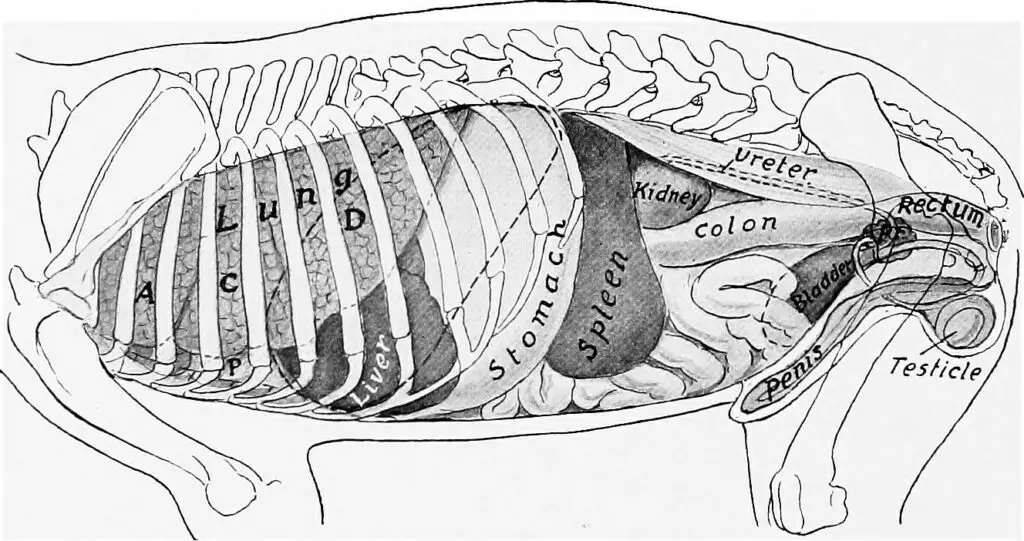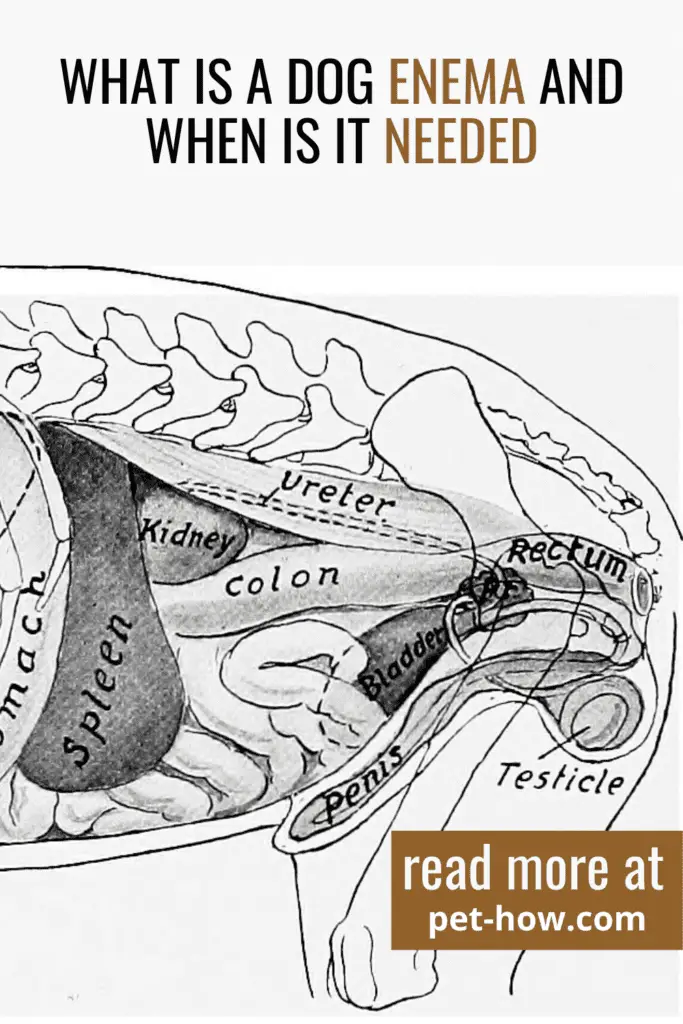Enemas can be an effective tool in treating many different ailments in dogs.
Enema is a process where the dog’s colon is flushed when the dog can’t do it itself for some reason.
The type of enema used will depend on the underlying problem and should be discussed with your veterinarian before giving any treatment to your pet.
What Is a Dog Enema

An enema is a type of treatment that involves flushing the colon of your pet with liquid or gas, typically through an injection tube.
It can be prescribed by a vet for health issues such as constipation or impaction, where some form of blockage has built up in the intestines, preventing normal evacuation and leading to symptoms such as bloating and discomfort.
The goal of enemas is to help break down and flush out this blockage so that it can pass out of the body naturally.
Enemas are commonly used on dogs and cats but may be used on other animals as well.
(Related: What To Expect After a Dog Enema (Answered!)
What Is a Dog Enema And When Is It Needed
Understanding The Anatomy of a Dog’s Digestive System
The first part of a dog’s digestive system is the esophagus. This muscular tube begins at the back of the mouth and extends down to the stomach.
Food travels through the esophagus to be broken down by stomach acids, enzymes, and other digestive juices.
Next, food enters the stomach where it continues to be broken down by strong acids, enzymes, and bile.
The stomach also stores food for up to four hours before passing it along for further digestion in the small intestine.
Here, nutrients and water are absorbed into the body before being sent to the large intestine or colon.
The colon absorbs water and electrolytes from undigested material, which then becomes feces that is passed out through the rectum.
After leaving the small intestine, undigested food passes through the large intestine and rectum.
In the large intestine, bacteria break down any remaining nutrients in the food before it is excreted out of the body as waste.
The rectum is a short tube that connects the large intestine to the anus, where feces is released from the body.
The last part of a dog’s digestive system is composed of several accessory organs that work together to help digestion.
These include the liver, gallbladder, pancreas, and salivary glands. The liver produces bile which helps break down fats into fatty acids for easy absorption by cells in the digestive tract.
The gallbladder stores bile until needed for digestion. The pancreas produces enzymes that help break down proteins, fats, and carbohydrates in food.
The salivary glands produce saliva which helps to moisten the mouth and start the digestion of carbohydrates.
(See more: How To Prepare Your Dog And Perform An Enema)
What Is a Dog Enema And When Is It Needed
Different Types of Enemas For Dogs
Enemas for dogs come in a variety of forms. Some enema treatments help to clear blockages, others are used to introduce medications or fluids into the body.
Depending on your pet’s condition and needs, there are different types of enemas available to treat them.
- Lubricant Enema: This type of enema is made up of a lubricant such as mineral oil, glycerin, or petroleum jelly. These lubricants help make it easier for stool to pass through the colon, making it useful if your dog is constipated or impacted. It helps reduce friction between the walls of the colon and any hard stools that may have formed during constipation.
- Hypertonic Saline Enema: This type of enema uses a saline solution with a higher concentration than normal. It is used to help draw fluids from the body and into the colon, which can help reduce inflammation and irritation in the intestine.
- Sterile Water Enema: This type of enema helps clear blockages caused by mucus buildup or impacted stool in the rectum. The sterile water helps break down any buildup so that it can be passed out of the body more easily.
- Barium Enema: A barium enema is given if your pet has swallowed something they shouldn’t have (such as a toy). Barium is a safe dye that shows up on x-rays, allowing vets to get an internal view of the digestive system. This type of enema is also used to diagnose or monitor conditions such as inflammatory bowel disease or cancer.
- Medicated Enemas: These enemas contain a variety of medications that can help treat your pet’s condition, depending on the issue at hand. Medicated enemas are usually prescribed by your vet and may contain antibiotics, anti-inflammatories, antispasmodic, or other medications.
Although beneficial, enemas can have side effects in dogs.
How Do Enemas Work On Dogs?
Enemas are used to help clean out the lower colon of dogs. They work by introducing a fluid, such as lukewarm water or a special solution, into the rectum and large intestine.
This works to soften and loosen any compacted material that can be causing blockages in the digestive tract.
The solution also helps to stimulate contractions in the large intestine, which aids in moving waste products along the digestive tract.
Once this is done, it allows for easier passage of fecal matter through the anal canal.
Overall, enemas can provide many benefits for your dog’s digestive health if administered properly. Dogs that suffer from constipation or impacted stool may experience relief after an enema treatment.
Additionally, an enema can also be used to help introduce medications into the large intestine.
This helps ensure that the medication is absorbed properly, which can be especially beneficial for pets with certain medical conditions.
What Is a Dog Enema And When Is It Needed
When Is Enema Needed For My Dog
- Constipation: If your dog is having difficulty passing stool or is straining excessively, it may be a symptom of constipation and an enema can help to alleviate this condition. This is especially true if the problem persists for more than two days.
- Bloat: Enemas can be used as part of emergency treatment for bloat in dogs, which is a life-threatening condition where the stomach becomes overstretched due to gas accumulation.
- Intestinal Blockage: If your dog has an intestinal blockage, an enema can be used to help flush it out and clear the obstruction.
- Pre-Surgery Cleanse: An enema may be given before a surgical procedure in order to cleanse the intestine of any bacteria or food particles that could cause infection during the operation. This is particularly important for animals undergoing abdominal surgery.
- Parasites: Certain types of parasites, such as hookworms and roundworms, can be flushed out using an enema if they are present in large numbers within the digestive tract.
- Abdominal Pain: Enemas can reduce inflammation and soothe abdominal pain in your pet, as well as help to expel any gas that has accumulated.
- Anal Gland Problems: If your pup is experiencing discomfort due to the presence of impacted or infected anal glands, an enema can be used to flush out the contents and provide relief.
What Should I Use To Give My Dog An Enema?
When giving your dog an enema, it’s important that you choose the right supplies. The type of enema used depends on the size of your dog and the severity of his condition.
For small dogs or puppies, a syringe with lubricant can be effective for administering an enema. For larger dogs, a special canine enema kit may be necessary.
Commonly used items for canine enemas include:
- A tub to put the dog in during administration
- A specially designed enema bag
- An appropriate lubricant (such as KY Jelly)
- Plastic tubing and clamps to regulate fluid flow
- A soft rectal nozzle
- Gloves and a mask for the person administering the enema
It is also important to use warm water or saline solution, depending on your veterinarian’s instructions. If using an over-the-counter product, be sure to follow all directions carefully.
Never use any products not specifically designed for canine enemas.
Finally, make sure you have plenty of towels and other clean materials on hand to help contain any messes.
It is also important that you are comfortable working with your dog in order to make the process as stress-free as possible.
Proper preparation will ensure that giving your dog an enema goes smoothly and safely.
What Is a Dog Enema And When Is It Needed
In Conclusion
Giving dogs an enema can be beneficial for their health, especially if they are constipated.
However, you need to consult with your veterinarian first.
Depending on what is causing the dog’s problem, the veterinarian will suggest which type of enema is best.






Leave a Reply